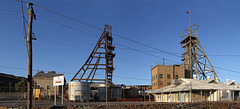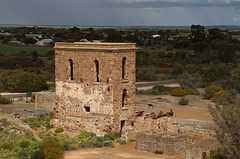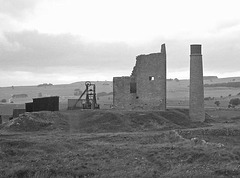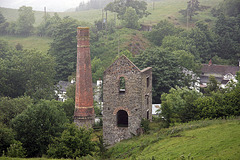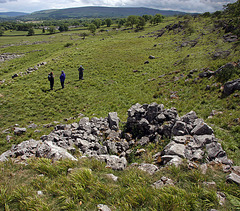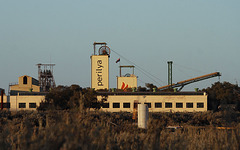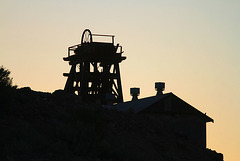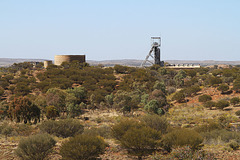
Metal Mining
Skelton Park Ironstone Mine
| |
|
The Skelton Park mine was sunk by Bell Brothers in 1872 with two shafts of 378 ft (upcast) and 384 ft (downcast), both 14ft in diameter. Bell Brothers were taken over by Dorman Long and Co Ltd in 1923 and that company operated the mine until closure in 1938. It is reckoned that the mine produced in excess of 18.5 million tons of ironstone.
This is the top of the upcast shaft and fan house although initially ventilation was by a furnace at the bottom of the shaft. In November 1882 a 12ft 1½ins diameter Schiele fan was installed in a concrete house with a steam engine to drive it. The shaft top brickwork was raised by 8ft to allow cross girders to be installed to carry a pulley wheel for winding in the shaft. The concrete structure to the left of the shaft is the evasee for the fan.
Rasp Mine
| |
|
|
Production at the Rasp Mine in central Broken Hill has a long and profitable history. Development ceased in 2008 when metal prices fell but as since resumed and the mine currently employs c160 people. Annual production is planned to average 34,000 tonnes of zinc metal in concentrate, 28,000 tonnes of lead metal in concentrate, and 1.1 million ounces of silver in the lead concentrate.
Richmans Enginehouse
| |
|
|
The Moonta mines in South Australia were operating from 1860 until 1923 and produced about 170,000 tons of copper metal. There are still extensive remains of the industry to be seen around the area and this includes a number of enginehouses. This example was completed in 1869 and housed a 32 inch Cornish beam engine driving crushing and concentration machinery. The engine ceased operation in 1917 and was replaced by a gas engine.
Magpie Mine
| |
|
|
The disused Magpie lead mine in Derbyshire UK. These are the best preserved surface remains to be found on any of the old Derbyshire lead mines.
Hendre Mine Rhydymwyn
| |
|
|
This engine house once provided electric power for the pumps on Taylor's shaft and elsewhere on the Hendre lead mine. It was erected in 1917 and has laid derelict for many years.
Tankerville Mine
| |
|
|
Tankerville mine was worked for lead and also barytes, calcite, silver and zinc intermittently between 1865 and 1925. The structures seen here relate to the Watson's shaft completed in 1874 to a depth of 1690 feet. The pumping engine was a 40" cylinder cornish type.
Danger
| |
|
Well, what would you do?
Yes it was dangerous and it was deep!
Old Lead shaft near Minera.
Modern ropeway
| |
|
|
It was a long way off across the hills, but I couldn't resist the sight of an aerial ropeway in action. This fairly modern ropeway carries ore from the Xiaotieshan Lead/Zinc mine over the hills for several kilometres and down to the Sanyelan smelter of the Baiyin non-ferrous Metal Group.
Pibble
| |
|
|
High up in the hills above Creetown stand the remains of the Pibble mine which produced lead and a small amount of copper in the 1840s and early 1850s. The enginehouse is supposed to have accommodated a pumping engine supplied to the Creetown Copper & Lead Mining Co in 1852 by Hodges' St Austell Foundry. However, there is evidence on the site that suggests that the works were not completed and it may be that the fine building was erected more to persuade investors of the substantial nature of the undertaking rather than to meet any actual pumping rquirement.
Sadly, the bob wall has collapsed into the shaft and the remaining walls will not last too much longer.
Acid tank arrival
| |
|
Sulphuric acids tanks arriving at Baiyin Gongsi yard from one of the many smelting works in the area. This train had two attempts to surmount the gradient before this successful run. In the background is a lead smelter with (I believe) a shot tower on the left.
Chopwood kiln
| |
|
I knew nothing about chopwood kilns until I attended a walk around the Kilnsey area of Wharfdale lead by Janis Heward who has made a detailed study of this industrial process. Chopwood kilns produced the dried wood (whitecoal) used as fuel in the ore hearth lead smelting process. The coppiced wood was placed on a grid of large green timbers in the low dry stone-walled structure with a narrow entrance built into a bank. In the pit below a controlled fire was burned to dry the timber above. There are many of these structures to be found in various ruinous states in the northern lead smelting areas. This example is one of the better preserved examples on a hillside between Threshfield and Kilnsey.
Janis has produced an interesting web page all about these kilns .
Holman Brothers
| |
|
Cornish influence in metal mining can be found all over the world. This compressed air powered hauling engine supplied by Holman Brothers of Camborne is at the old lead/zinc smelter in Namtu in north-east Burma. It was used to haul ladles of hot metal away from the furnaces.
Best viewed large .
Marmion Shaft
| |
|
Marmion Shaft at the Bawdwin lead/zinc mine in north-east Myanmar. It was sunk in 1914 down to the sixth (adit) level at c700ft and was subsequently deepened to serve 14 levels in total to a depth of 1700ft. The winding house contains two electric winders manufactured at the Siemens Works of English Electric at Stafford in the UK in 1925. The ore is trammed out of the mine via a two mile adit known as "Tiger Tunnel".
Industrial Baiyin
| |
|
SY 0206 charges into Gongsi Yard at Baiyin with the lead/zinc smelter and shot tower behind.
Telpher man
| |
|
Coke movement from the storage bunkers at the Port Pirie smelter is by this telpher and grab. Mangrove Rat suggested an early start to catch the light around the harbour and smelter area, and it was certainly worth the effort.
North Broken Hill Consolidated Mine
| |
|
Perilya operates the NBHC Mine, although it is now controlled by Chinese metal company Shenzhen Zhongjin Lingnan Nonfemet Co., Ltd. The shaft on the left isover Main Shaft at Zinc Mine where operation ceased in 1988. The central headframe is the skip winding shaft which was refurbished in 1988 and has a capacity of 2.9 million tonnes per year. The right headgear is for the service shaft with cages.
Thompson Shaft
| |
|
|
The Thompson Shaft at British Mine, Broken Hill, was developed from 1910 as this area took over the main production. Winding from this shaft appears to have ended in 1958.
North Mine, Broken Hill
| |
|
The No.3 shaft at North Mine in Broken Hill is the deepest in Australia at 1600 metres. It was commenced in 1948 and commissioned in 1962. Production here finally ended in the mid-1990s.
Jump to top
RSS feed- Latest items - Subscribe to the latest items added to this album
- ipernity © 2007-2024
- Help & Contact
|
Club news
|
About ipernity
|
History |
ipernity Club & Prices |
Guide of good conduct
Donate | Group guidelines | Privacy policy | Terms of use | Statutes | In memoria -
Facebook
Twitter


